| Rye %: | 61% |
| Stages: | 2-stage rye sponge, Wheat sponge, Soaker, Final dough |
| Leaven: | Rye sour culture |
| Start to Finish: | 26-30 hours |
| Hands-on Time: | 45-60 minutes |
| Yield: | Two 28 oz/800 g loaves |
If there’s a rye bread equivalent of the Perfect Storm – that is, when all the ideal conditions come together at the same time – this bread is it. Start with the formula for a classic South Tyrolean Merano Rye from Austrian master baker/blogger Dietmar Kappl, then use it to showcase two spectacular artisan flours – California-grown Abruzzi rye from Grist & Toll and organic heritage emmer from Maine Grains – and you come up with a bread that’s very, very special.
Like most Alpine ryes, this one is built on multiple sponges – a 2-stage sour rye sponge and a one-stage emmer (wheat) sponge seeded with rye sour culture. The result is an amazingly complex, well-balanced sour that complements the sweet nuttiness of emmer, the fragrance of fennel and the spicy sweetness of this earthy heirloom rye. A stale rye bread soaker adds tenderness to the open crumb, encased in a dry baked, chewy crust.
When I first tasted this bread, I was at a loss for what to pair it with: frankly, almost anything I could think of would only, to my mind, become a distraction from this extraordinary chew. So here’s my suggestion: Don’t pair it with anything. Eat it unadorned, or perhaps with a light coating of sweet butter and concentrate on this wonderful symphony of flavors.
Stage 1 Rye sponge (Day 1, Afternoon):
| Ingredient | Grams | Ounces | Baker’s Percentage |
| Wholegrain or Medium rye flour | 85 | 3.00 | 100% |
| Warm (105°F/41°C) water | 110 | 3.90 | 129% |
| Rye sour culture | 7 | 0.25 | 8% |
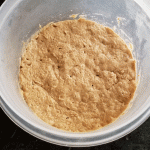 In a bowl, combine the Stage 1 rye sponge ingredients by hand, cover and ferment at room temperature (70°F/21°C) 16-24 hours. The sponge will have a strong sour aroma, and will have begun to fall back on itself.
In a bowl, combine the Stage 1 rye sponge ingredients by hand, cover and ferment at room temperature (70°F/21°C) 16-24 hours. The sponge will have a strong sour aroma, and will have begun to fall back on itself.
Wheat sponge (Day 1, Evening):
| Ingredient | Grams | Ounces | Baker’s Percentage |
| AP or bread flour | 150 | 5.30 | 100% |
| Warm (105°F/41°C) water | 150 | 5.30 | 100% |
| Rye sour culture | 7 | 0.25 | 5% |
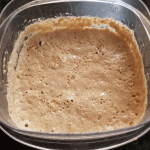 In a separate container, combine the Wheat sponge ingredients, cover and ferment at room temperature for 16-20 hours. The sponge will have a strong sour aroma, and will have begun to fall back on itself.
In a separate container, combine the Wheat sponge ingredients, cover and ferment at room temperature for 16-20 hours. The sponge will have a strong sour aroma, and will have begun to fall back on itself.
Stage 2 Rye sponge (Day 2, Midday):
| Ingredient | Grams | Ounces | Baker’s Percentage |
| Stage 1 sponge | 202 | 7.10 | 122% |
| Wholegrain or Medium rye flour | 165 | 5.80 | 100% |
| Warm (105°F/41°C) water | 290 | 10.25 | 176% |
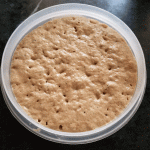 Add the Stage 2 sponge ingredients to the Stage 1 sponge, hand mix until blended, cover and ferment at room temperature for 3-4 hours. The sponge will have nearly tripled in volume and show broken bubbles on the surface.
Add the Stage 2 sponge ingredients to the Stage 1 sponge, hand mix until blended, cover and ferment at room temperature for 3-4 hours. The sponge will have nearly tripled in volume and show broken bubbles on the surface.
Soaker (Day 2, Midday):
| Ingredient | Grams | Ounces | Baker’s Percentage |
| Stale rye bread, broken | 70 | 2.45 | 100% |
| Warm (105°F/41°C) water | 180 | 6.35 | 257% |
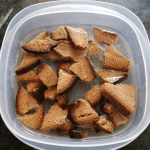 In a separate container combine the Soaker ingredients and let stand at room temperature for 2-4 hours.
In a separate container combine the Soaker ingredients and let stand at room temperature for 2-4 hours.
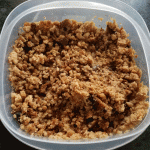 When the bread has softened, mash it finely with a fork.
When the bread has softened, mash it finely with a fork.
Final Dough: (Day 2, Afternoon)
| Ingredient | Grams | Ounces |
| Stage 2 rye sponge | 657 | 23.20 |
| Wheat sponge | 307 | 10.85 |
| Soaker | 250 | 8.80 |
| Wholegrain or Medium rye flour | 300 | 10.60 |
| AP or bread flour | 200 | 7.05 |
| Warm (105°F/41°C) water | 150 | 5.30 |
| Salt (1¼ Tbs) | 22 | 0.80 |
| Fennel seed (1 Tbs) | 5 | 0.20 |
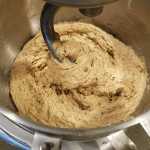 In the mixer bowl, combine the final dough ingredients and use the dough hook at low (KA2) speed to mix until fully blended into a soft, moderately sticky dough that begins to gather around the hook, 5-6 minutes. Cover and ferment at room temperature until the dough has visibly expanded and shows broken bubbles on the surface, 30-40 minutes.
In the mixer bowl, combine the final dough ingredients and use the dough hook at low (KA2) speed to mix until fully blended into a soft, moderately sticky dough that begins to gather around the hook, 5-6 minutes. Cover and ferment at room temperature until the dough has visibly expanded and shows broken bubbles on the surface, 30-40 minutes.
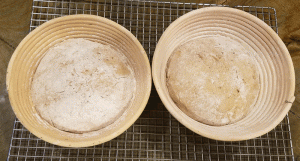 Turn the dough onto a well-floured work surface and divide into two pieces, weighing just over 2 lb/935 g. Shape into rounds or oblongs and place them, seam-side down, into well-floured proofing baskets.
Turn the dough onto a well-floured work surface and divide into two pieces, weighing just over 2 lb/935 g. Shape into rounds or oblongs and place them, seam-side down, into well-floured proofing baskets.
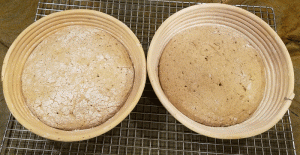 Cover and proof at room temperature until the dough has expanded to about 1½ times its original volume and shows cracks or broken bubbles, 35-40 minutes.
Cover and proof at room temperature until the dough has expanded to about 1½ times its original volume and shows cracks or broken bubbles, 35-40 minutes.
Preheat the oven to 480°F/250°C with the baking surface in the middle. Bake without steam for 7 minutes, then reduce the temperature to 390°F/200°C and continue baking until the loaves thump when tapped with a finger and the internal temperature is at least 198°F/92°C, 45-50 minutes. Transfer to a rack and cool thoroughly before slicing.
Baker’s Percentages:
| Ingredient | g | % |
| TOTAL FLOUR | 900 | 100.00% |
| Whole or medium rye flour | 550 | 61.11% |
| AP or bread flour | 350 | 38.89% |
| Water | 700 | 77.78% |
| Salt | 22 | 2.44% |
| Rye sour culture | 14 | 1.56% |
| Soaker water | 180 | 20.00% |
| Stale bread | 70 | 7.78% |
| Fennel, ground | 5 | 0.56% |
| TOTAL FORMULA | 1,891 | 210.11% |
| Flour prefermented | 400 | 44.44% |

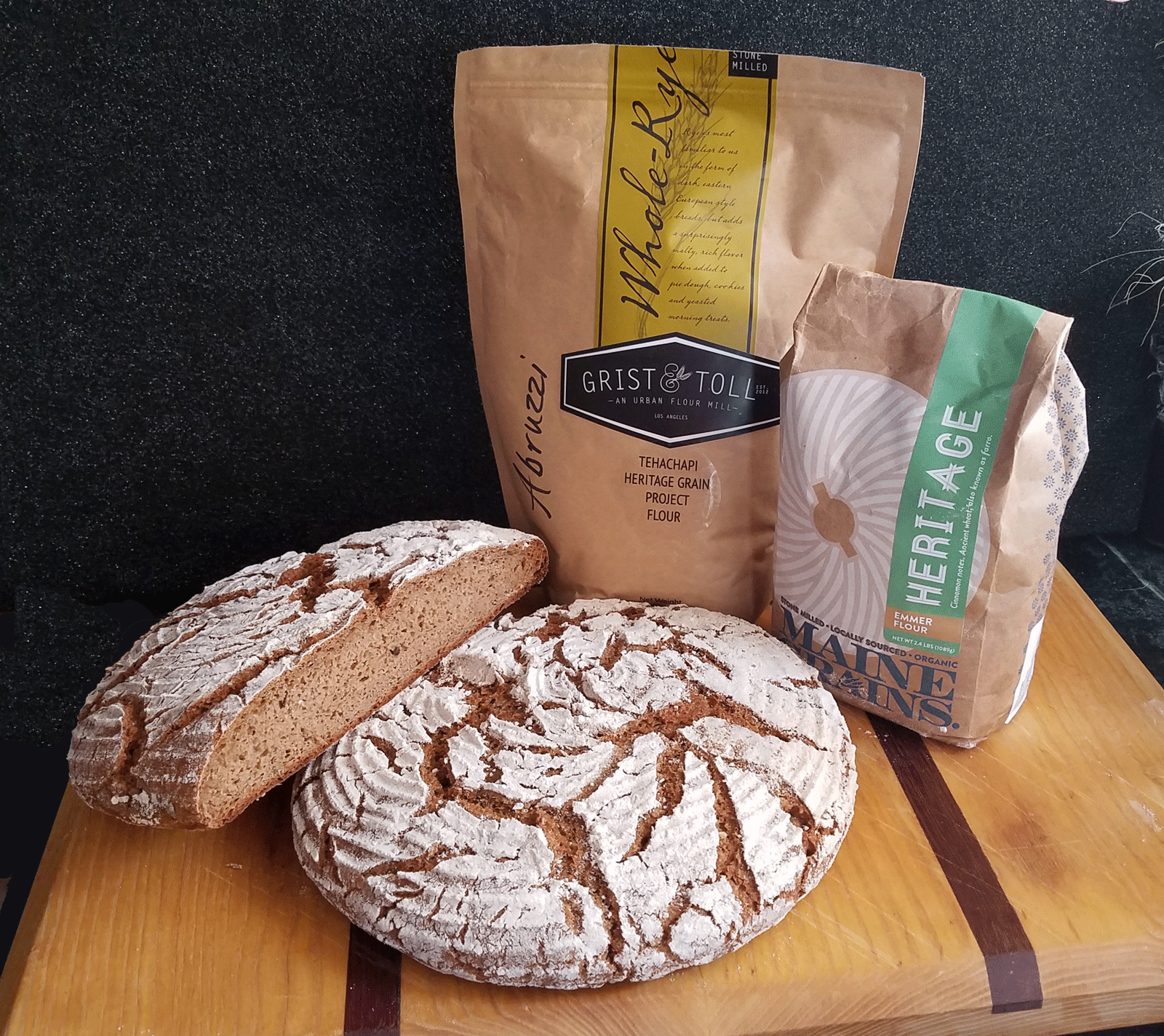

Brad Prezant
August 26, 2017Wow. Drooling already.
Karin Anderson
August 28, 2017Beautiful loaves!
Dietmar Kappl’s blog is a great source for breads, I do appreciate that he is willing to share his recipes even though he works in a bakery.
The little package of emmer grains, a welcome gift from the Maine Grain Alliance) that I sowed in my front yard just yielded a harvest of about 1/4 cup (but I bought some emmer at the Kneading Conference, too). I’m really glad that Maine farmers grow heritage grains again, and I can get Maine rye now from my supplier.
Mark Woodward
September 11, 2017The flavor of this bread is superb! Having neither emmer nor Abruzizi rye, I made it with freshly milled generic organic rye from my local organic market and Anson Mills’ French heritage white flour. I found the hydration level way too high, even after discarding the excess water from the soaker (next time I’ll save it and discard excess filtered water). I should have remembered that that white flour absorbs less water than many bread flours and that my freshly milled rye also seems less absorptive than some, but I didn’t think to hold some water back until it was too late. Shaping was out of the question so I just scooped the dough into a short Pullman pan. I got great oven rise, to the extent that the top burst half off (next time, if I do it this way again, I’ll score the top). So I’ve got a great sandwich bread rather than a hearth bread, but, like I said, the flavor is exceptionally good, and the crumb relatively soft and open. I’ll definitely be making more of these.